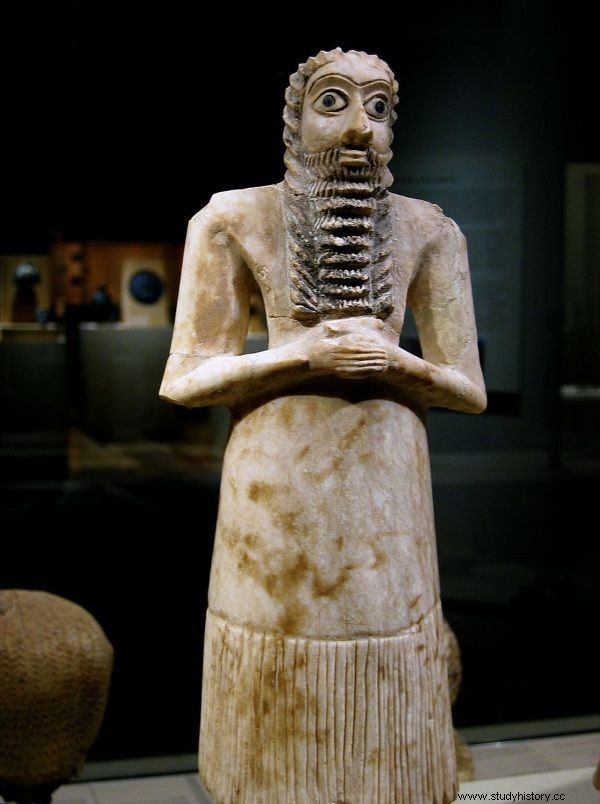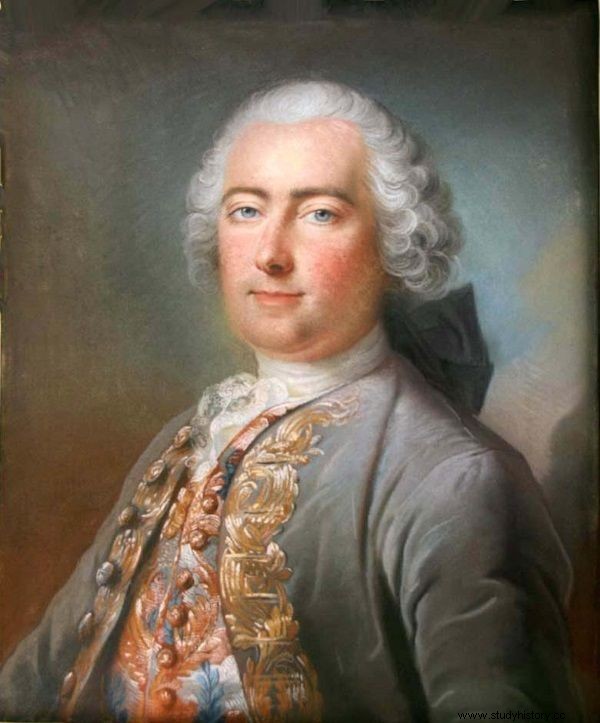Male makeup? This is no metrosexuality or a strange 21st-century novelty. The idea of makeup guys is as old as beer, the wheel, and the division of time into days and weeks. It was invented by the Sumerians and only developed in the following ages.
1. Make-up in the land of the fertile crescent

Alabaster Mesopotamian statue. On the man's face you can see that his relatives put a lot of emphasis on the appearance of the eyes. (Photo:Rosemaniakos from Bejing, license CC 2.0)
One of the cradles of makeup is the Euphrates and Tigris valleys. Scientists, conducting excavations over the years, have found a lot of evidence that the people living there emphasized their beauty as early as the fourth millennium BC. They used perfumes and oils, but most of all, they improved their appearance with makeup. In tombs, both male and female, shells were found in which cosmetics were stored. After testing them, it turned out that they contain pigment residues of various colors - red, white, blue, green, yellow and black.
The Sumerians, both men and women, wore heavy makeup. The eyes played the most important role in him. They were highlighted with black eyeliner and colored shadows. To further strengthen the eye frame, eyebrows and eyelashes were also blackened to make them look more refined. To complete the fashionable look, the hair was curled in fine spirals and perfumed. The Sumerians dyed their faces white with lead white, and painted their cheeks red with henna. Archaeologists also discovered that they were using ... fake beards.
2. Egyptian cat's eye

Tutankhamen's mask with visible make-up (photo:tdittmar75, license CC0)
We recently wrote about makeup in ancient Egypt which had both a practical and symbolic meaning. Also in the land of the pharaohs, men did not refuse to emphasize their beauty. Just pay attention to the famous golden mask of King Tutankhamen, found in 1922 by Howard Carter.
The most famous Egyptian ruler, who owes fame to this image, has clearly painted eyes on it. The use of an appropriate cosmetic on the eyelids was to serve not only aesthetic, but also magic and hygiene. Eyes were painted to resemble Ra's eye, and cosmetics helped to prevent pollination and the development of disease.
3. Lipstick in the Eternal City

Emperor Nero with light skin and highlighted cheeks. (photo:public domain)
Along with the development of the Rommanum Empire and the conquests of subsequent provinces, beauty trends and cosmetics from every corner of the world at that time permeated the Eternal City. The Romans attached great importance to hygiene, as evidenced by the popularity of baths and other sanitary installations.
While formal use of makeup by men and women, especially in excess, was considered immoral, it was not condemned. Even Ovid in his metamorphoses admitted that not everyone receives beauty from the grace of the gods. To help themselves, the men emphasized their eyes, rose cheeks and lips, and ... painted over their baldness. A well-known makeup lover was Neron, among others.
4. Pale skin is not due to the English weather

Elizabeth I's trusted advisor Tudor William Cecil, Lord Burghley. The whiteness of her complexion and flushed cheeks does not seem to be due to the English air. (photo:public domain).
From many portraits we know the image of Queen Elizabeth I (reigning in 1533-1603), whose face, smoothed with makeup, looks more like a porcelain doll than a human face. Meanwhile, during the reign of Edward IV York, who sat on the same throne a century earlier and was a famous womanizer, it was the king who was a supporter of improving his beauty.
Fashionable men then aimed at having a very fair complexion. That is why in the paintings they have almost white faces and barely pink lips. This is not due to British rainy weather and lack of sun, but the use of whitening powders.

The whole problem is that bleach was obtained from lead, and their frequent and passionate use led to poisoning with a harmful element. This pursuit of beauty could even lead to premature death. Arsenic whitewash had a similar effect on the health.
Cosmetics containing harmful substances damaged the skin, and over time, to get the same effect, it was necessary to apply them and more. Eventually, the face began to resemble an artificial white mask. Interestingly, scammers in medieval England used makeup to mimic the symptoms of leprosy in order to allow them to be allowed to rib.
5. The court of the French Ludwik

Louis-François de Livet (photo:public domain)
Looking at the images of eighteenth-century French hipsters, it's hard not to ask if the spouses who only saw each other wearing make-up would be able to recognize their half of soute . Under Louis XVI, both men and women spent a fortune on beautifying, and the last thing that could be said about their makeup was that it was light or natural.
The most important, as in previous eras, was the powder. First of all, it provided fashionable white skin. As baths were not popular at that time, and even considered a harmful practice, the powder also masked dirt, and also covered the signs of aging and traces of diseases. In order to get rid of the effect of a uniform mask, gentlemen, apart from powdering the face, also applied blush, usually in the shape of a triangle or a circle, as well as blackened eyebrows and painted lips. You also had to put on a properly styled and powdered wig, stick or draw an artificial mole and you could throw yourself into the whirlwind of court life.
The French Revolution brought a dramatic cut in the history of makeup. After the great coup over the Seine, everything that was associated with the aristocracy began to be despised. In England, Queen Victoria ascended the throne soon after, banning all makeup. Fashion had to change. For over a hundred years, until the advent of cinema, only men and women playing in theaters were painted. And… prostitutes.
Information sources:
- Eldridge L., Face Paint. Make-up history , Znak Horyzont, Krakow 2017.
- Hallmann-Mikołajczyk A., Ancient Egyptian make-up, "Quarterly of the history of material culture", 2006, no. 1.
- Marwick A., A History of Human Beauty, London, New York 2004.
- Schwabe C.W., Cattle, Priests, and Progress in Medicine, Minnesota 1978.
- Taylor L., The Study of Dress History, New York 2002.
